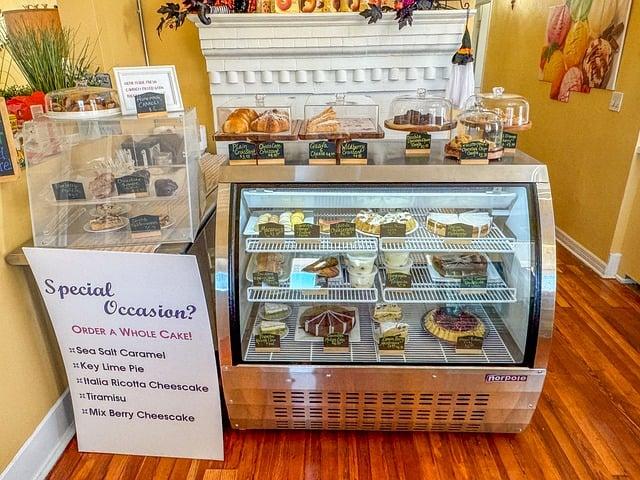In the heart of Provence, as the winter sun dipped below the horizon, families gathered around a table adorned with a feast of 13 desserts. This cherished French tradition, rooted in Christmas celebrations, symbolized the Last Supper, where each dessert represented a different apostle. From the sweet, sticky nougat to the fragrant spiced fruits, each bite told a story of abundance and gratitude. Laughter filled the air as children savored candied fruits and adults toasted with rich, velvety wine, celebrating not just the season, but the bonds that sweetened their lives.
Table of Contents
- Exploring the Origins and Significance of the 13 Desserts Tradition
- A Sweet Symphony: The Essential Components of the 13 Desserts
- Crafting Your Own 13 Desserts: Tips and Recipe Ideas
- Celebrating with 13 Desserts: Pairing and Presentation Suggestions
- Q&A

Exploring the Origins and Significance of the 13 Desserts Tradition
The tradition of the 13 desserts is deeply rooted in the Provençal region of France, where it is celebrated during the Christmas season. This unique culinary custom symbolizes the Last Supper, with each dessert representing one of the apostles, while the thirteenth dessert is often dedicated to Christ. The selection of desserts varies by family and locality, but common choices include nougat, calissons, fruits (such as figs and grapes), and bûche de Noël. Each dessert carries its own significance, often reflecting the agricultural bounty of the region and the importance of sharing and hospitality during the festive season.
Beyond its delicious offerings, the 13 desserts tradition serves as a reminder of the values of community and togetherness. Families gather to share these sweets, fostering connections and creating lasting memories. The act of preparing and presenting the desserts is as significant as the treats themselves, often involving generations of recipes passed down through time. This celebration not only highlights the rich culinary heritage of Provence but also reinforces the cultural importance of food as a means of bringing people together during the holidays.

A Sweet Symphony: The Essential Components of the 13 Desserts
In the heart of Provence, the tradition of the 13 desserts embodies a rich tapestry of flavors and textures, each component telling a story of the region’s agricultural bounty and cultural heritage. These desserts are not merely sweet treats; they symbolize the Last Supper, with each item representing a different aspect of the Christian faith. The selection typically includes a delightful array of **dried fruits**, **nuts**, and **pastries**, creating a harmonious balance that captivates the senses. Among the most cherished are **figs**, which symbolize abundance, and **almonds**, representing prosperity. The inclusion of **nougat** and **calissons** adds a touch of local craftsmanship, showcasing the artistry of Provençal confectioners.
As the table is adorned with these delectable offerings, the experience becomes a communal celebration, inviting family and friends to gather and share in the joy of the season. Each dessert plays a vital role in this sweet symphony, with **chestnuts** and **raisins** providing warmth and comfort, while **orange slices** and **pomegranate seeds** introduce a refreshing burst of flavor. The tradition encourages creativity, allowing families to personalize their selections, ensuring that every gathering is unique. Ultimately, the 13 desserts serve as a delicious reminder of the importance of sharing, gratitude, and the rich culinary heritage that defines this festive occasion.

Crafting Your Own 13 Desserts: Tips and Recipe Ideas
Embracing the French tradition of 13 desserts offers a delightful opportunity to explore a variety of flavors and textures. Each dessert holds its own significance, often representing the bounty of the harvest and the richness of the region. When crafting your own selection, consider incorporating a mix of traditional and modern elements. **Classic choices** include:
- Nougat – A chewy confection made with nuts and honey.
- Calissons – Almond-shaped candies made from ground almonds and candied fruit.
- Fruits – Fresh seasonal fruits like figs, grapes, and oranges.
- Chocolate – Rich, dark chocolate truffles or a simple chocolate mousse.
- Tartes – Mini fruit tarts or a traditional tarte Tatin.
Experimenting with these elements allows for personal touches, such as adding a favorite family recipe or a contemporary twist to a classic dish.
When assembling your 13 desserts, presentation is key. Consider using a beautiful platter or individual serving dishes to showcase each dessert. **Incorporate textures and colors** to create visual appeal, and think about the balance of flavors—sweet, tart, and creamy. You might also want to include some **unique ideas** like:
- Macarons – Delicate and colorful, these can be filled with various flavors.
- Cheesecake bites – Miniature versions of this classic dessert.
- Spiced nuts – A crunchy contrast to the sweetness of the other desserts.
- Custards – Silky smooth and can be flavored with vanilla, chocolate, or citrus.
- Ice cream – A refreshing addition, especially in warmer months.
By thoughtfully selecting and presenting your desserts, you can create a memorable experience that honors this cherished French tradition while adding your own flair.

Celebrating with 13 Desserts: Pairing and Presentation Suggestions
When it comes to the French tradition of 13 desserts, the art of pairing and presentation plays a crucial role in enhancing the experience. Each dessert, from the rich buche de Noël to the delicate nougat, offers a unique flavor profile that can be beautifully complemented by carefully selected accompaniments. Consider serving the fruits confits alongside a light, sparkling wine to elevate the sweetness, while the creamy panna cotta pairs wonderfully with a drizzle of tangy fruit coulis. For a more traditional touch, a selection of cheeses can be included, providing a savory contrast to the sweetness of the desserts.
Presentation is equally important in this festive celebration. Arrange the desserts on a large, ornate platter, allowing each item to shine in its own right. Use decorative elements such as edible flowers or fresh herbs to add color and vibrancy to the display. Individual servings in small glass jars or elegant cups can create an intimate feel, inviting guests to indulge in each treat. Don’t forget to label each dessert with charming tags, providing a brief description of its significance in the tradition. This thoughtful approach not only enhances the visual appeal but also enriches the storytelling aspect of the 13 desserts, making the celebration truly memorable.
Q&A
-
What are the 13 desserts?
The 13 desserts are a traditional Provençal custom served during the Christmas season, symbolizing Jesus and the 12 apostles. They typically include:
- Nougat
- Calissons (almond candies)
- Dried fruits (like figs and dates)
- Fresh fruits (such as apples and pears)
- Various pastries and cakes
- Chocolate
- And more, depending on local variations.
-
Why are there 13 desserts?
The number 13 is significant as it represents the Last Supper, where Jesus dined with his 12 apostles. Each dessert is meant to honor this tradition and reflect the abundance of the season.
-
When are the 13 desserts served?
The 13 desserts are typically served on Christmas Eve after the family meal, as part of the festive celebration leading into Christmas Day.
-
Are the 13 desserts always the same?
No, the specific desserts can vary by region and family tradition. While some items are commonly included, others may be substituted based on local customs or personal preferences.
In the heart of Provence, the tradition of the 13 desserts weaves a tapestry of flavors and stories, celebrating abundance and unity. As you savor each sweet bite, remember that this festive custom is a delicious reminder of heritage and togetherness.

大家好,我是彼得潘,專業的手法身體治療師。我喜歡探索和研究各種主題,並透過與人工智慧的合作分享專業、實用、有趣的文章。我們定期進行人工審核,以確保內容的準確性。如果您發現文章中有任何不準確的地方,請隨時與我們聯繫,我們會及時糾正。您可以透過 [email protected] 與我們聯繫。



